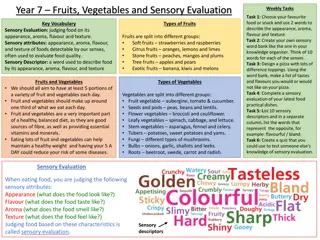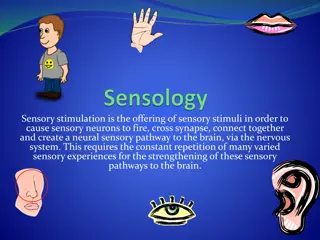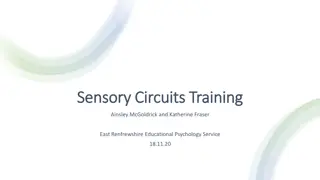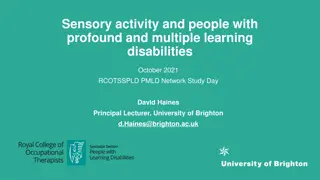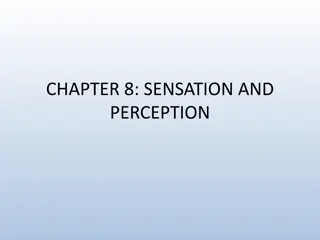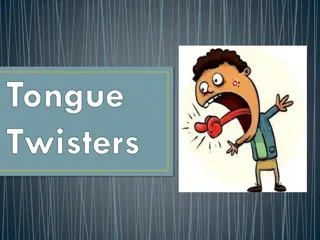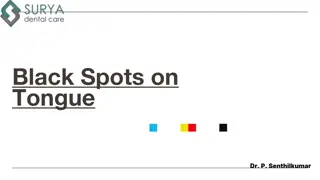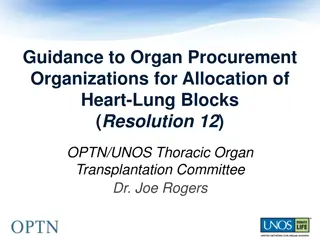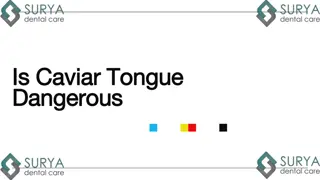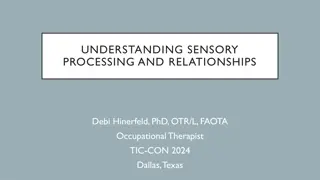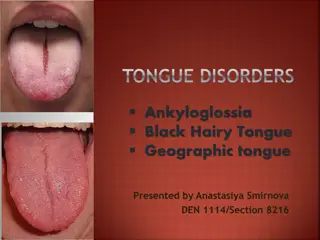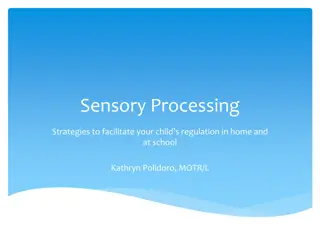Understanding the Physiology of the Sensory Organ - Tongue by B.K. Singh
Taste perception on the tongue is a vital sensory function involving sweet, sour, salty, and bitter sensations. The tongue, with its muscular movements and taste buds, plays a crucial role in mastication, swallowing, and food enjoyment. Different types of papillae on the tongue are responsible for taste perception. This comprehensive overview sheds light on the anatomy, physiology, and significance of the tongue in sensory perception.
Download Presentation

Please find below an Image/Link to download the presentation.
The content on the website is provided AS IS for your information and personal use only. It may not be sold, licensed, or shared on other websites without obtaining consent from the author. Download presentation by click this link. If you encounter any issues during the download, it is possible that the publisher has removed the file from their server.
E N D
Presentation Transcript
PHYSIOLOGY OF SENSORY PHYSIOLOGY OF SENSORY ORGAN ORGAN- -TONGUE TONGUE B.K.SINGH,DAIRY TECHNOLOGY
PHYSIOLOGY OF SENSORY ORGAN-TONGUE Taste is defined as those sensations perceived in the mouth (almost exclusively on the tongue) which have to do sweetness, sourness, saltiness and bitterness. Taste stimuli are all soluble in water. Taste also includes esthetic appreciation. Significance: It commands interest of consumers helps in recognition, selection, acceptance, and pleasantness. Complete removal of taste buds result in dietary deficiency, contributes to the enjoyment of food. Taste is initiated by contact of an aqueous solution of a chemical with the taste buds on the surface of the tongue and the adjacent regions of the mouth & throat. Dilute substances affect only the tongue. Stronger solutions elicit pain & sharpness in mouth.
The tongue facilitates by its muscular movements, which bring the taste materials into contact with the taste buds. The movement of tongue also constantly disturbs concentration gradients near the receptors and then tends to prevent adaptation to a given stimulus intensity. It helps in mastication, rolling food round in the mouth to ground and make acceptable to the stomach in addition to swallowing also. The length and weight of tongue is approximately 10 cm. and 56g, respectively. In general tongue is chiefly composed of striated muscle. The fibers of which are grouped into bundles that interlace with one another. They are disposed in three directions --longitudinal, traverse and vertical giving maximum mobility & physical control. The tongue is covered by mucous membrane. The dorsal surface of tongue is divided by circumvallate papillae into anterior 2/3 and posterior 1/3.
THE ANATOMY OF THE TONGUE WITH RECEPTORS
PAPILLAE The papillae are raised portion of the tongue, i.e. are the organs of taste. They are four different types of papillae which classified on the basis of shape. Fungiform: Large, round, mushroom like in appearance, 0.8 -1.0 mm. in diameter, 1.0 -1.5 mm. high, greater in number at the tip and sides of the tongue, 150 -400 in no. It contains taste buds. Filiform: Evenly distributed on the anterior 2/3, most numerous in number, but have no taste buds. It is keratinized structure, helps in movement of food. It contains endings specialized for tactile sense. Foliate: Located on the posterior third of the tongue (in folds and on the sides). Not well developed in man and has little function. Circumvallate: Form a V -shape on the back of the tongue, usually 6-15 in no., large 2 mm. high, 1.0 - 1.5 mm. deep, easily visible, contains taste buds.
Circumvallate papillae (CP) are bigger than other papillae and are arranged in a v-shaped way in the back of the tongue near the throat. Most people have from 12 circumvallate These papillae are used to taste bitter. These sensors can make a person gag from bad tastes. CP are also called vallate papillae. 6 to papillae.
FUNCTIONS Help in movement of food, contains endings specialized for touch (Filiform), give rise to taste sensations (Fungi, circumvallate). With age , number. of papillae varies, becoming less in no., and more restricted in distribution. The tongue is insensitive to taste in the regions, where there are no papillae. Taste sensitivity is confined mainly to the tips & edges and absent in the middle of the tongue.
TASTE BUDS Taste buds are Organ detecting taste/ Taste receptors Taste is sensed by the taste buds, which are located in the papillae on the tongue. The taste receptors are group of sensory epithelium cells. They have been identified and described as similar to flower bud, ever since the term " 'taste-bud' retained. Few buds exist in the mucosa of soft palate, in children on the sides and in the roof of the mouth. They do occur in the nose. Taste bud in fungi form -occur on their upper surface. Taste bud in Foliate & Circumvallate -lie in their grooves. Human taste buds located on moist surface within the oral cavity and pharynx that are lined with stratified epithelium.
The number of taste buds per papillae varies from 33 to 508, averaging about 250. Each bud contains about 5 to 10 taste cells. Taste buds -also referred as taste onions -are spindle shaped cells bulging out at the root and coming together as the taste -pore -like petal of bud. Taste buds are 0.7-mm. long and 0.05 mm. wide at their widest diameter. With in the taste -bud are supporting cells & gustatory cells, arranged to enclose a chamber to give a bud - like structure. Taste bud looks like microscopic rosebuds. Their tasting action is a chemical process. Food must be liquefied before any real taste emerges. It binds to receptor cell of bud, a minute Electro-chemical current generated and passed by cranial nerves to gustatory terminals in the brain. The degree of the taste sensations depends on Solubility, Ionization (in case of acids & salt) and Temperature
SALIVA Saliva (commonly referred to as spit) is an extracellular fluid produced and secreted by salivary glands in the mouth. In humans, saliva is 99.5% water plus electrolytes, mucus, white blood cells, epithelial cells (from which DNA can be extracted), enzymes (such as amylase and lipase), antimicrobial agents such as secretory IgA, and lysozymes. Saliva is the key ingredient in food digestion, and helps protect teeth from decay, prevents infection, and makes chewing and swallowing possible. Without saliva we wouldn t be able to break down food for proper digestion or wash away food and debris afterward.
THE ROLE OF SALIVA Saliva is mainly secreted by three-paired set of glands. The parotid in the cheeks with a duct (thin & watery). The Sub maxillary opens from the floor of the mouth (both). The sublingual openings beside the membrane (thick & mucous). Characteristics of saliva Saliva varies in viscosity and amount. Usually serous type, mainly secretion from parotid. It contains about 99.5% water, 0.5% total solids (composed of salts, organic substances). A modest amount of gases is also present in saliva. The pH of saliva varies, but is usually slightly acidic (6.35 to 6.85). After meals -pH rose sharply, but fell quickly to a slow lower point -just before meals.
Natural secretion of saliva is brought about by: Stimulation of nerves in the mouth -food in the mouth. By stimulation of sense organs other than taste. Ingestion of fluids -stimulates mucous saliva. Semi solid -thick, lubricating & diluting saliva. Chewing, smoking, dry fruits, salt, acid etc. stimulates flow of saliva. Fear, emotion -cause temperature suppression. Functions: Chemical digestion: breaks down starch by the function of "salivary amylase". Helps chewing and swallowing. Lubricating effect: moisturizes the inside of the mouth and creates smoother speech. Solvent effect: dissolves food and allows the tongue to taste food. Cleaning effect: washes away food debris and bacteria remaining in...
TASTE QUALITIES There are four basic taste -sweet, salt, sour and bitter. There is a regional distribution of the four types of the receptors to create area of sensitivity on the tongue. Some sensory authorities believe that there may be several other taste reactions, namely alkaline, metallic, watery and/or meaty. Feelings in the mouth such as common chemical/pain sense, warmth, coolness, anesthesia and other feelings are not taste reactions, but are sensations of touch/pressure. The true basic tastes may be sensed with the nose obstructed. astringency, smoothness,
RELATIVE INTENSITY It is the comparison of the taste intensity of the different tastes, by constructing psychological scales of taste intensity. It is measured in the unit called "Gust"- the concentration of different tastes (relative strength) that matched I % sucrose was called "a Gust". Relative intensity of Sucrose: NaCI : Citric Acid: Quinine hydrochloride is 1 : 14 : 220 : 2300.
REACTION TIME The reaction time to taste i.e. "interval between initial stimulation of the receptor and the 1 report of reaction". It can also be defined as "the interval of time between the application of tne solution being tasted on the tongue and the appearance of the sensation. In electro-physiological studies, the reaction time was estimated at 0.02 -0.06 sec.. whereas oral reaction time was estimated to be: 0.307 sec. for salt 0.536 sec. for sour 0.446 sec. for sweet 1.082 sec. for bitter Thus, reaction time is not identical for all basic tastes. In comparison to other senses, tastes have the slowest reaction, hence, maximum reaction time.
TASTE SENSITIVITY Taste sensitivity varies with individuals and with temperature. Salt & quinine Sulphate - threshold increases with temperature, that of HCI remains constant from 62.6 - 107.6 F for dulcin decreases from 17 -35 C and rises slightly at 42 C. The concentration of a substance (in saliva) required to triggered the taste, is higher than the concentration (in air) required for odor. Time is one factor, concentration is an another.
TASTE THEORIES It was suggested that any theory of taste must account for the following: The taste receptors respond rapidly to a chemical stimulus All substances tasted must be in a liquid(soluble) form A variety of substances stimulate taste receptors The threshold concentration for stimulation are not large Many taste substances do not result in any rapid deterioration of the receptor cell i.e. nonphysiological
The taste receptors rapidly elicits a steady level of response with a magnitude that is a function of the concentration of the applied stimulus The response to many substance remains constant over a long period of adaptation Receptor stimulation must be followed by electrical depolarization of end organ itself A water rinse rapidly reduces the taste response The receptors are the site of the chemical specificity There are genetic variations in taste ability. The response of NaCI between 20-30'C and pH of 3-11 is almost independent of temperature Different species reveal different cationic series of taste receptor excitability
ENZYME THEORY It is proposed that enzyme activity near nerve fibers produces ionic changes, which induce the formation of nerve impulses. The taste substance would inhibit enzymes in some sites, leaving enzymes in other sites unaffected, thereby producing a change in the pattern of impulses reaching the brain. Thus, different tastes could be distinguished. This theory provides an explanation of why substances of widely differing chemical composition can have similar taste. Limitation: the magnitude of taste response is independent of temperature, whereas enzyme reactions are very dependent on temperature.
BEIDLER'S THEORY According to this theory, taste sensation is dependent on: -the particular types of chemo receptors that are activated -the magnitude of their response -the pattern of nerve discharge over each taste nerve fiber He assumed that the gustatory reaction follows the mass action law and if the law applies the interaction of a stimulus with a given substance of the receptor is expressed by the expression: Kc = n/(s-n) -> eqn 1 where, n = the total no. of ions/molecule that react with the receptors at concentration 'c' of applied stimulus. s= the max no. of ions that can react K = the equilibrium constant
If the magnitude of Response (R) is proportional to the no. of ions that have reacted, then R= a*n where (a =constant) For maximum response, Rm= a*s, substituting in eqn 1 Kc= R/(Rm-R) or C/R = C/Rrn + I/KRm This equation relates magnitude of response to the concentration of the applied stimulus. Note: C=I/K when R=Rm/2. If C/R is plotted against C, a straight line should result with slope = I/Rm and a Y intercept equal to I. This equation is similar to the adsorption isotherm Longmuir, and similar equations have been used to express binding of ions by proteins. There is little reason to assume that there is only one type of stimulating mechanism for all types of taste substances. This is emphasized by the fact that sour and salty tastes are primarily elicited by electrolytes, whereas bitter and sweet tastes may be elicited by either.
ADSORPTION THEORY According to this theory, taste substances participate in an adsorption process, possibly with proteins, at the surface of the receptor. This results in a sapid depolarization of the receptor surface, which spreads to the attached nerve fiber and excites it. Adsorption results in a slight changes in the spatial configuration of there. A leakage follows of some ionic species (probably potassium) from the interior, decreasing the normal potential across the receptor membrane. The spread of this local polarization over the rest of the cell surface may stimulate the innervating nerve, either by chemicals or electrical means, such that the frequency of nerve impulses generated is proportional to the magnitude of receptor depolarization. Threshold concentration depends not only on the strength with which the stimulus is attached to the receptor site but also on the no. of sites available to the particular stimulus, for this reason, the effectiveness of the response may vary at low and high concentrations.
TASTE SPECTRUM THEORY It is believed that the so-called primary tastes are merely points of familiarity on a taste "spectrum". The determining factor in taste quality is thought to depend on: -the stimulative effectiveness of the substance -the penetration or adsorption of the compound by the receptors. The receptors are differently susceptible to the penetration or adsorption. The taste spectrum concept does not exclude regional localization of end organs of quantitatively different susceptibility. As per him, there are two series of stimulatory substance: polar & non- polar. By this theory, a substance, which is both sweet and sour, would be difficult to explain.
TIME INTERVAL BETWEEN TASTING/ EFFECT OF AFTER TASTE After tastes do persists, some of the same quality as the preceding sensation and some quite different. Sweet compounds often have bitter aftertaste, and vice- versa. After tasting KCI solution or tasting Amla fruit or dilute HCI solution, then tasting water produces sweet sensation. A pause (interval) ranging from 2-5 min between each two stimuli has been suggested to allow the taste organs to return to normal taste conditions. It also helps in overcoming carryover of preceding taste,
TASTE INHIBITION AND MODIFICATION Substances have been discovered which have ability to change the perception of taste quality . E.g. GYMNEMAGENIN able to suppress the sweet taste MIRACLE FRUIT ~changes perception of sour to sweet They have taste modifying proteins. TASTE SENSITIZERS: They condition the taste organs for keener perception or render them to normal sensitivity over a prolonged period of tasting. E.g. salt, mild acids (1% NaCI solution for mouth rinsing/ fruits eaten between judging two samples of dairy products)
TASTE INHIBITORS: They render taste organs less able to perceive delicate taste reactions. e.g. sugar, cream, cheese inhibitory effect on tasting, cause fatigue. All fail to stimulate flow of saliva. ANESTHESIA: Term used to designate temporary impairment of sense of taste e.g. ice cream. For this, it is necessary to expectorate ice cream in mouth to get it at body temperature, which helps to sense true taste.



